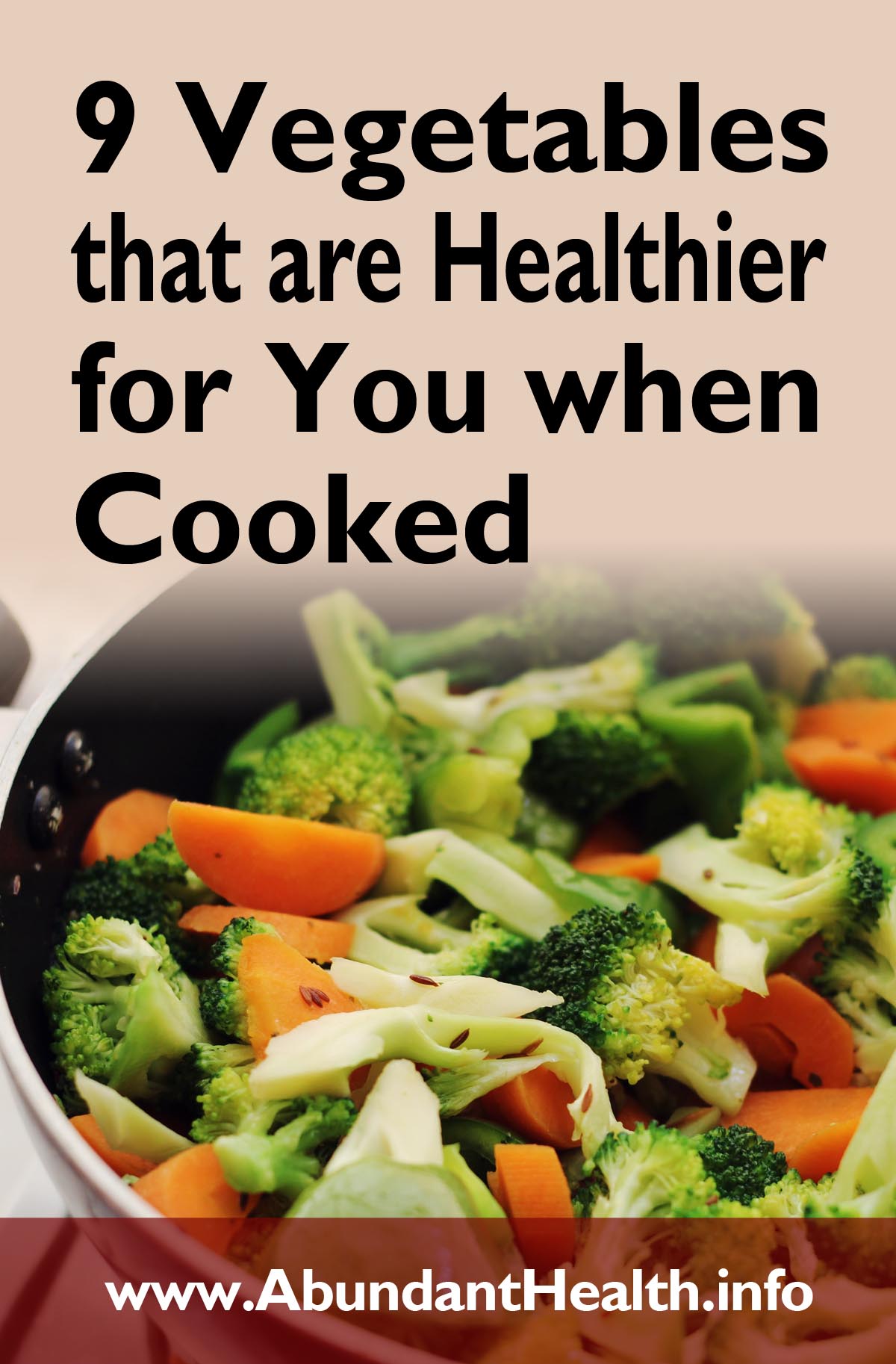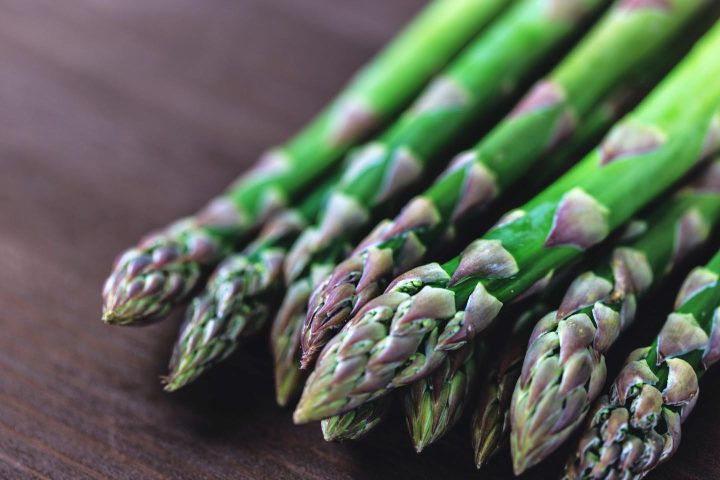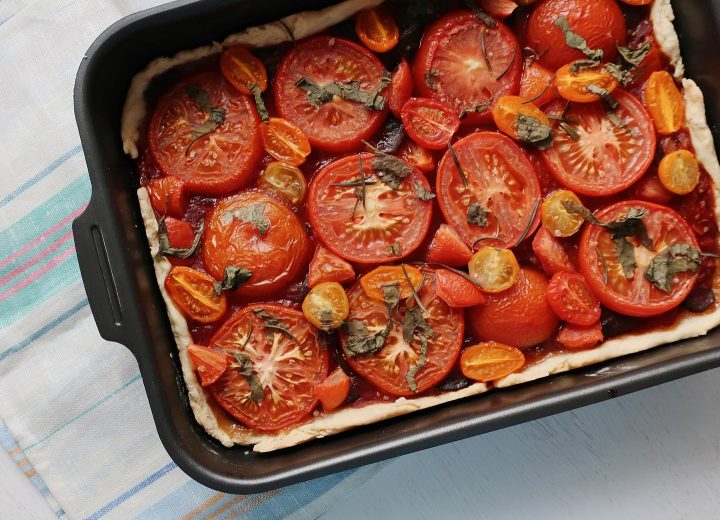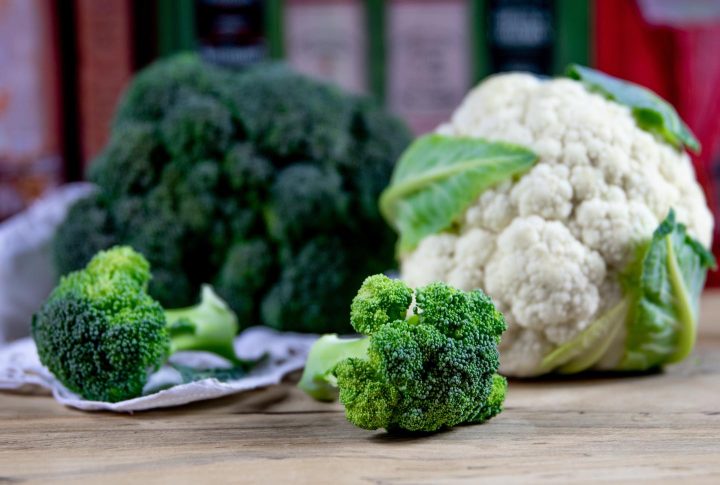Raw food diets are a fairly recent trend, including raw veganism. The belief being that the less processed food is, the better. However, not all food is more nutritious when eaten raw. Indeed, some vegetables are actually more nutritious when cooked. Here are nine of them.

1. Asparagus
All living things are made up of cells, and in vegetables, important nutrients are sometimes trapped within these cell walls. When vegetables are cooked, the walls break down, releasing the nutrients that can then be absorbed more easily by the body.1)Gibson R et.al. Improving the bioavailability of nutrients in plant foods at the household level. Proceedings of the Nutrition Society (2006), 65, 160–168
Cooking asparagus breaks down its cell walls, making vitamins A, B9, C and E more available to be absorbed.

2. Mushrooms
Mushrooms contain large amounts of the antioxidant ergothioneine, which is released during cooking.2)Rodriguez Estrada, A.E., Lee, HJ., Beelman, R.B. et al. Enhancement of the antioxidants ergothioneine and selenium in Pleurotus eryngii var. eryngii basidiomata through cultural practices. World J Microbiol Biotechnol 25, 1597–1607 (2009). https://doi.org/10.1007/s11274-009-0049-8 Antioxidants help break down “free radicals”, chemicals that can damage our cells, causing illness and ageing.
3. Spinach
Spinach is rich in nutrients, including iron, magnesium, calcium and zinc. However, these nutrients are more readily absorbed when the spinach is cooked. This is because spinach is packed with oxalic acid (a compound found in many plants) that blocks the absorption of iron and calcium. Heating spinach releases the bound calcium, making it more available for the body to absorb.3)Gibson R et.al. Improving the bioavailability of nutrients in plant foods at the household level. Proceedings of the Nutrition Society (2006), 65, 160–168
Research suggests that steaming spinach maintains its levels of folate (B9), which may reduce the risk of certain cancers.4)Neerja Rana, Arti Ghabru and Devina Vaidya. Defensive function of fruits and vegetables. Journal of Pharmacognosy and Phytochemistry 2019; 8(3): 1872-1877
4. Tomatoes
Cooking, using any method, greatly increases the antioxidant lycopene in tomatoes. Lycopene has been associated with a lower risk of a range of chronic diseases including heart disease and cancer.5)Sanjiv Agarwal and Akkinappally Venketeshwer Rao. Tomato lycopene and its role in human health and chronic diseases. CMAJ September 19, 2000 163 (6) 739-744; This increased lycopene amount comes from the heat that helps to break down the thick cell walls, which contain several important nutrients.
Although cooking tomatoes reduces their vitamin C content by 29%, their lycopene content increased by more than 50% within 30 minutes of cooking.6)Dewanto V, Wu X, Adom KK, Liu RH. Thermal processing enhances the nutritional value of tomatoes by increasing total antioxidant activity. J Agric Food Chem. 2002 May 8;50(10):3010-4. doi: 10.1021/jf0115589.

5. Carrots
Cooked carrots contain more beta-carotene than raw carrots, which is a substance called a carotenoid that the body converts into vitamin A. This fat-soluble vitamin supports bone growth, vision and the immune system.
Cooking carrots with the skins on more than doubles their antioxidant power.7)Miglio C et. al. Effects of Different Cooking Methods on Nutritional and Physicochemical Characteristics of Selected Vegetables. J. Agric. Food Chem. 2008, 56, 1, 139–147. https://doi.org/10.1021/jf072304b You should boil carrots whole before slicing as it stops these nutrients from escaping into the cooking water. Avoid frying carrots as this has been found to reduce the amount of carotenoid.8)Abdollah Ghavami, W. Andy Coward and Les J. C. Bluck. The effect of food preparation on the bioavailability of carotenoids from carrots using intrinsic labelling. British Journal of Nutrition , Volume 107 , Issue 9 , 14 May 2012 , pp. 1350 – 1366
DOI: https://doi.org/10.1017/S000711451100451X
6. Bell peppers
Bell peppers are a great source of immune-system-boosting antioxidants, especially the carotenoids, beta-carotene, beta-cryptoxanthin and lutein. Heat breaks down the cell walls, making the carotenoids easier for your body to absorb.9)Feng X. et.al. omparative analysis of carotenoids and metabolite characteristics in discolored red pepper and normal red pepper based on non-targeted metabolomics. https://doi.org/10.1016/j.lwt.2021.112398 As with tomatoes, vitamin C is lost when peppers are boiled or steamed because the vitamin can leach out into the water. Try roasting them instead.
7. Brassica
Brassica, which include broccoli, cauliflower and brussels sprouts, are high in glucosinolates (sulfur-containing phytochemicals), which the body can convert into a range of cancer-fighting compounds. For these glucosinolates to be converted into cancer-fighting compounds, an enzyme within these vegetables called myrosinase has to be active.
Research has found that steaming these vegetables preserves both the vitamin C and myrosinase and, therefore, the cancer-fighting compounds you can get from them. Chopping broccoli and letting it sit for a minimum of 40 minutes before cooking also allows this myrosinase to activate.10)Vallejo, .F., Tomás-Barberán, .F. & García-Viguera, .C. Glucosinolates and vitamin C content in edible parts of broccoli florets after domestic cooking. Eur Food Res Technol 215, 310–316 (2002). https://doi.org/10.1007/s00217-002-0560-8
Similarly, sprouts, when cooked produce indole, a compound that may reduce the risk of cancer. Cooking sprouts also causes the glucosinolates to break down into compounds that are known to have cancer-fighting properties.11)Cieślik E et. al. Effects of some technological processes on glucosinolate contents in cruciferous vegetables. Food Chemistry, Volume 105, Issue 3, 2007, Pages 976-981, https://doi.org/10.1016/j.foodchem.2007.04.047.

8. Green beans
Green beans have higher levels of antioxidants when they are baked, microwaved, griddled or even fried as opposed to boiled or pressure cooked.12)Jiménez-Monreal A et. al. Influence of Cooking Methods on Antioxidant Activity of Vegetables. https://doi.org/10.1111/j.1750-3841.2009.01091.x
9. Kale
Kale is healthiest when lightly steamed as it deactivates enzymes that prevent the body from using the iodine it needs for the thyroid, which helps regulate your metabolism.13)Curley P. Dietary and Lifestyle Interventions to Support Functional Hypothyroidism. Inquiries Journal 2009, Vol. 1 No. 12
For all vegetables, higher temperatures, longer cooking times and larger quantities of water cause more nutrients to be lost. Water-soluble vitamins (C and many of the B vitamins) are the most unstable nutrients when it comes to cooking because they leach out of vegetables into the cooking water. So avoid soaking them in water, use the least amount of water when cooking and use other cooking methods, such as steaming or roasting. Also, if you have cooking water left over, use it in soups or gravies as it holds all the leached nutrients.

Stay Always Up to Date
Sign up to our newsletter and stay always informed with news and tips around your health.
This article is republished from The Conversation under a Creative Commons license. Read the original article.

Laura Brown is researching on the impact of a plant-based diet on health. Her professional experiences are divided between delivering training, workshops and lecturing, and she is passionate about working with individuals to encourage and promote healthy eating and exercise patterns in order to reduce obesity and improve overall health.
References
| ↑1 | Gibson R et.al. Improving the bioavailability of nutrients in plant foods at the household level. Proceedings of the Nutrition Society (2006), 65, 160–168 |
|---|---|
| ↑2 | Rodriguez Estrada, A.E., Lee, HJ., Beelman, R.B. et al. Enhancement of the antioxidants ergothioneine and selenium in Pleurotus eryngii var. eryngii basidiomata through cultural practices. World J Microbiol Biotechnol 25, 1597–1607 (2009). https://doi.org/10.1007/s11274-009-0049-8 |
| ↑3 | Gibson R et.al. Improving the bioavailability of nutrients in plant foods at the household level. Proceedings of the Nutrition Society (2006), 65, 160–168 |
| ↑4 | Neerja Rana, Arti Ghabru and Devina Vaidya. Defensive function of fruits and vegetables. Journal of Pharmacognosy and Phytochemistry 2019; 8(3): 1872-1877 |
| ↑5 | Sanjiv Agarwal and Akkinappally Venketeshwer Rao. Tomato lycopene and its role in human health and chronic diseases. CMAJ September 19, 2000 163 (6) 739-744; |
| ↑6 | Dewanto V, Wu X, Adom KK, Liu RH. Thermal processing enhances the nutritional value of tomatoes by increasing total antioxidant activity. J Agric Food Chem. 2002 May 8;50(10):3010-4. doi: 10.1021/jf0115589. |
| ↑7 | Miglio C et. al. Effects of Different Cooking Methods on Nutritional and Physicochemical Characteristics of Selected Vegetables. J. Agric. Food Chem. 2008, 56, 1, 139–147. https://doi.org/10.1021/jf072304b |
| ↑8 | Abdollah Ghavami, W. Andy Coward and Les J. C. Bluck. The effect of food preparation on the bioavailability of carotenoids from carrots using intrinsic labelling. British Journal of Nutrition , Volume 107 , Issue 9 , 14 May 2012 , pp. 1350 – 1366 DOI: https://doi.org/10.1017/S000711451100451X |
| ↑9 | Feng X. et.al. omparative analysis of carotenoids and metabolite characteristics in discolored red pepper and normal red pepper based on non-targeted metabolomics. https://doi.org/10.1016/j.lwt.2021.112398 |
| ↑10 | Vallejo, .F., Tomás-Barberán, .F. & García-Viguera, .C. Glucosinolates and vitamin C content in edible parts of broccoli florets after domestic cooking. Eur Food Res Technol 215, 310–316 (2002). https://doi.org/10.1007/s00217-002-0560-8 |
| ↑11 | Cieślik E et. al. Effects of some technological processes on glucosinolate contents in cruciferous vegetables. Food Chemistry, Volume 105, Issue 3, 2007, Pages 976-981, https://doi.org/10.1016/j.foodchem.2007.04.047. |
| ↑12 | Jiménez-Monreal A et. al. Influence of Cooking Methods on Antioxidant Activity of Vegetables. https://doi.org/10.1111/j.1750-3841.2009.01091.x |
| ↑13 | Curley P. Dietary and Lifestyle Interventions to Support Functional Hypothyroidism. Inquiries Journal 2009, Vol. 1 No. 12 |
Leave a Reply